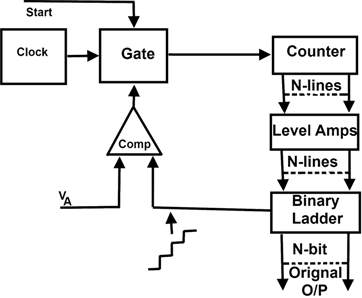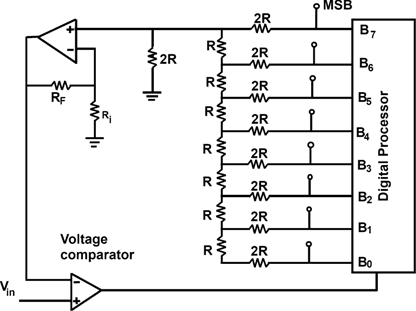Analog to Digital Conversion (ADC)
The process of converting an analog voltage into an equivalent digital signal is know as analog to digital (ADC) conversion. Although a pure analog system is capable of better accuracy than a digital system, its accuracy is rarely completely usable because it is presented in a form that cannot be read, recorded or interpreted to such high accuracy. This is why pure analog data are converted to digital form. Digital data, however are readily presented in numerical form, and are easily manipulated, processed, stored and recorded.
A great variety of ADC has been made to satisfy a broad spectrum of requirements. In some applications the dominant parameters are the precision and stability of conversion, in others conversion speed is of greatest important. There are various type of analog to digital converters. Some of them are given as under:
- Counter type ADC
- Successive Approximation type ADC
Counter Type ADC
Figure 1 shows the block diagram of counter type ADC. As shown, it comprises on input voltage comparator a clock generator, a gate and n-bit counter.
To begin with, the counter is reset to all 0's. Then a converted signal appears on the start-lie, the input gate is ENABLED and the clock pulses are allowed to the counter's clock input. The counter advances through its normal binary count sequence, the staircase waveform is generated at the output of the binary ladder constituting a DAC. This staircase waveform forms one of the inputs of the comparator whose other input is the analog input signal. Whenever the binary ladder output exceeds the analog input voltage, the comparator changes state, the gate is DISABLED and the counter stops. The counter output is then the required digital output corresponding to analog input signal.

The counter type ADC provides a very good method for digitizing to a high resolution. This method is much simpler than the simultaneous method for high resolution, but the conversion time required is longer. Since the counter always begins at zero and counts through its normal binary sequence , it may require as many as 2n counts before conversion is complete. The average conversion time is 2n / 2 or 2n-1 counts, where n is the number of bits of the counter.
Successive Approximation Method
Successive approximation ADC is much faster than the counter ADC. In an n-bit converter, the counter type ADC on an average would require 2n+1 clock cycles for each conversion whereas successive approximation type conversion requires only n clock cycles,
Figure 2 shows the bock diagram of successive approximate ADC, the operation is as follows.
Working
The output from the DAC are programmed to be all initially low, then DAC is at zero count. The MSB output bit of digital to analog converter is caused to go high and the comparator is sensed for a state changed. If the change occurs the MSB output from the digital to analog converter is returned to low, as the digital to analog converter output voltage was greater than the input voltage, if no change occurs the MSB output is left high.

The next lower DAC output bit is caused to go high and the comparator is sensed for a state change. If a change occurs the bit is returned to low, as the new DAC output voltage was greater than the input voltage. This process of changing the next lower DAC output bit and sensing teh comparator for a change is continued through the LSB of the DAC.
When the process is complete, the final DAC output states represent the digital equivalent of the step just below the actual input voltage magnitude. The whole requires a maximum of only 2n pulses to complete the entire analog to digital conversion.
Specifications
The major ADC specifications are resolution, accuracy and speed.
Resolution
The resolution for an ADC is defined as the change in analog input voltage for obtaining change in output by one bit. The resolution of ADC is given as
Resolution = ( E / (2n - 1) X 100%)
Accuracy
Accuracy is defined as the difference between the digital output values and the analog input values of the ADC.
Speed
Speed in converters is another important specification. In ADC converters speed is the time to perform one conversion.
